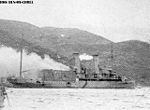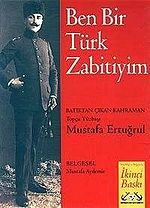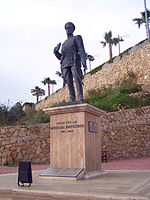- Mustafa Ertuğrul Aker
-
Mustafa Ertuğrul Aker 
Yüzbaşı Mustafa Ertuğrul (Aker) in 1927Born 1892, Hanya, Crete, Ottoman Empire Died 1961, Antalya, Turkey Allegiance Ottoman Empire, Turkey Rank Artillery captain Battles/wars World War I
Turkish War of IndependenceAwards Medal of Independence, Iron Cross Other work Wrote his memoirs of war Mustafa Ertuğrul (full name after the 1934 Law on Family Names in Turkey; Mustafa Ertuğrul Aker) was an officer of Ottoman Army during World War I and of Turkish Army in the early stages of the Turkish War of Independence (he was wounded near Aydın in 1919), who had accomplished a number of brilliant military feats, the most notable being the sinking of the British seaplane tender HMS Ben-my-Chree with shore fire. During the same campaign along the coasts of southwestern Turkey, he also sank the French auxiliary aviso Paris II and the converted naval trawler Alexandra.[1] and a number of other Allied vessels in the course of the year 1917.
Mustafa Ertuğrul was born in 1893 in Hanya to Turkish Cretan parents. His family remained in Crete until 1903 and then they moved to Istanbul where Ertuğrul attended the Ottoman Military Academy.[citation needed]
By the start of the Greco-Turkish War (1919-1922), he was assigned to Aydın region where he took up the task of organizing and training Demirci Mehmet Efe's efe militia units. He was wounded in an ambush in 1919 and he spent the rest of his life in Antalya as a disabled officer. Mustafa Ertuğrul died in 1964.
He married a daughter of his commander Şefik Bey (Aker). After the 1934 Surname Law, he chose same family name of his father-in-law.[2]
Ben bir Zabitiyim
 Ben-my-Chree burning and sinking after having been hit by shore fire while at the port in Kastelorizo
Ben-my-Chree burning and sinking after having been hit by shore fire while at the port in Kastelorizo
Mustafa Ertuğrul was recently rediscovered in Turkey thanks to research done on him and on the shipwrecks off the coast in Ağva Bay[3] near Kemer in Antalya Province by the skin diver and amphora collector Mustafa Aydemir.
A book based on the account Mustafa Ertuğrul had typewritten himself in 1934, on Atatürk's personal encouragement, "Ben bir Türk zabitiyim" (I am a Turkish officer), was re-edited by Aydemir and supplemented with photographs and archive documents, notably from France, and was published for the first time in 2004, running into several editions since. Prior to Ertuğrul's account having been, as such, made public, the general information on the officer was restricted to a few lines in the memoirs of Liman von Sanders and the Field Marshal Erich Ludendorff, as well as to documents and literature treating Ben-my-Chree's sinking. Paris II commander Henri Rollin, taken prisoner by Ertuğrul's unit after his ship's sinking, had also presented a detailed official report on Paris II and Alexandra at the end of the war in 1918. Ertuğrul's story remains open to more in-depth research, with a number of points included in his account awaiting further clarification, notably his mention of another British military vessel he claimed to have mortally touched and he thought was the actual ship commended by Charles Rumney Samson, HMS Dard.
References
- ^ These two French vessels are erroneously cited as cruisers in a number of sources.
- ^ Mustafa Ertuğrul’un öğretmen gelini:AYTÜLÜ AKER, Antalya Bugün, (Turkish)
- ^ Not to be confused with the town of Ağva on the Black Sea coast and near Istanbul, also significant for its wreckages of submarines dating, this time, from the Second World War and commonly referred to as "Hitler's lost fleet". See Jasper Copping. Article: "Adolf Hitler's 'lost fleet' found in Black Sea". Sunday Telegraph. http://www.telegraph.co.uk/news/main.jhtml?xml=/news/2008/02/03/whitler103.xml Article:.
Categories:- 1892 births
- 1961 deaths
- Cretan Turks
- People from Chania Prefecture
- People from Antalya
- Ottoman Imperial School of Military Engineering alumni
- Ottoman Army officers
- Ottoman military personnel of World War I
- Turkish military personnel of the Greco-Turkish War (1919–1922)
- Recipients of the Iron Cross
- Recipients of the Medal of Independence with Red Ribbon (Turkey)
Wikimedia Foundation. 2010.


